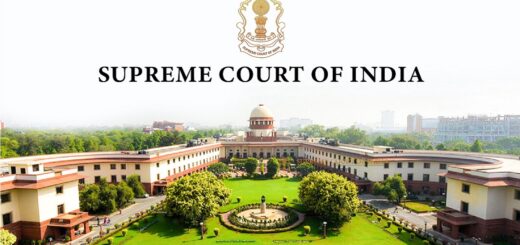The Supreme Court stated that not every private property can be seen as a material resource for the community.

The Supreme Court ruled today that the term “material resources of the community” in Article 39(b) of the Constitution does not cover all privately owned property that could be taken by the State for the common good. A nine-judge Bench issued three separate Judgments in this matter. One was written by Chief Justice Dr. D.Y. Chandrachud, joined by Justices Hrishikesh Roy, Rajesh Bindal, J.B. Pardiwala, Satish Sharma, Manoj Misra, and Augustine George Masih. Justice B.V. Nagarathna provided a separate concurring Judgment, while Justice Sudhanshu Dhulia offered a partially dissenting Judgment. The Bench addressed three main questions: First, whether Article 31C, as confirmed in the Keshavananda Bharati case, remains valid after the 42nd Amendment was invalidated in Minerva Mills v. Union of India (1980). Second, whether the interpretation of Article 39(b) from the State of Karnataka v. Ranganatha Reddy (1977) case and later in Sanjeev Coke Manufacturing v. Bharat Coking Coke (1982) should be re-evaluated. Third, whether the term “material resource of the community” can include privately owned resources.
The Court stated that if Article 39(b) was intended to cover all resources owned by individuals, it would clearly mention that ownership and control of resources should benefit the common good. Likewise, if it aimed to exclude privately owned resources, it would refer to ownership and control by the State instead of its current wording. The majority opinion noted that the phrase “of the community” suggests a deliberate choice by lawmakers to include some privately owned resources, but not all. The term “of the community” should be seen as different from individual ownership. The majority ruling also emphasized that interpreting Article 39(b) to encompass all privately owned resources would imply support for a specific economic ideology and structure. In the case of Ranganath Reddy, a seven-judge panel ruled 4:3 that privately owned resources were not part of the “material resources of the community.” Justice V. Krishna Iyer disagreed with the majority, advocating for a broader interpretation of Article 39(b). Five years later, in Sanjeev Coke, the Court accepted Justice Iyer’s interpretation while supporting the nationalization of coal mines. The Bench remarked that the terms in Article 39(b) should be viewed in light of the constitutional aim of creating a sovereign, socialist, secular, democratic republic. Although the term ‘socialist’ was added to the Preamble later, the goal of socialism has always been clear, as shown in the Directive Principles of State Policy.
A nine-judge Bench later confirmed the decision in Mafatlal Industries Ltd. v. Union of India (1997), agreeing with the interpretation from Sanjeev Coke. They stated that Article 39(b) covers both natural and physical resources, as well as movable and immovable property, which includes all sources for meeting material needs, not just public resources. In 2001, during the case of Property Owners Association v. State of Maharashtra, the Court identified a disagreement between the rulings of Ranganatha Reddy and Sanjeev Coke regarding Article 39(b). This led to the case being sent to a Bench of at least seven judges for further review. In 2002, the case was escalated to a nine-judge Bench. The majority found that Justice Iyer’s comments in Ranganatha Reddy were wrong in suggesting that all private property could be seen as a community resource. They decided that private property could only be considered a material resource if it met specific criteria. Today, the Court reinstated the original text of Article 31C, as upheld in Kesavananda Bharati v. State of Kerala. The original text stated that laws aimed at implementing the principles in Article 39(b) or (c) would not be invalidated for conflicting with rights under Articles 14, 19, or 31, and such laws could not be challenged in court for not fulfilling that policy. In Kesavananda Bharati, the first part was deemed valid, while the second part was struck down.
Justice Nagarathna noted that privately owned resources, apart from personal belongings, can be included in the term “material resources of the community” as stated in Article 39(b). She mentioned that the principles of liberalisation, privatisation, and globalisation have been in effect in India since 1991. The economic reforms and structural changes since that time reflect the socio-economic policies adopted in India after independence. Justice Nagarathna categorized material resources into two types: state-owned and privately owned. She explained that privately owned resources can become community resources, but this does not apply to personal items like household goods. Privately owned resources can gain community status through nationalisation, acquisition, legal processes, purchase from private owners, or through donations, gifts, or the establishment of public trusts. In his dissenting opinion, Justice Dhulia expressed agreement with the majority on Article 31C but disagreed with the interpretation of Article 39(b). He supported Justice Iyer’s broader view that “material resources of the community” includes privately owned property. He stated that managing and distributing these resources is the responsibility of the legislature, but if a law does not benefit the community, it can be invalidated.
Cause Title: Property Owners Association v. State of Maharashtra [W.P.(C) No. 934/1992]









